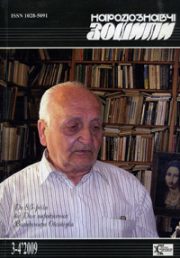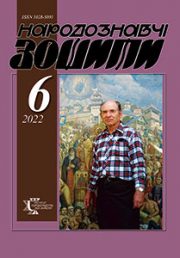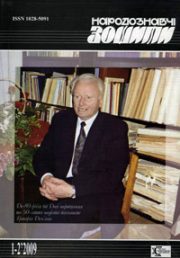The Ethnology Notebooks. 2021. # 2 (158), P. 262—277
УДК 392.31(477.41/.42)”19″
DOI https://doi.org/10.15407/nz2021.02.262
Olena KONDRATIUK
- ORCID ID: https://orcid.org/0000-0002-5996-1768
- Сandidate of History (Ph. D),
- Head of Department of Ethnology,
- State Scientific Center of Cultural Heritage Protection
- from Technogenic Catastrophes
- 21, Vyshgorodskaya st., 04114, Kyiv, Ukraine,
- e-mail: lenvin2007@gmail.com
TRANSFORMATION OF FAMILY-CEREMONIAL KINSHIP DURING THE TWENTIETH CENTURY
The system of kinship of the traditional Ukrainian society was not limited to consanguinity (loodline) spiritual kinship and relationship by marriage. It provided for kinship on the basis of common interests, place of residence or the performance of a certain rite some rituals. Therefore, the study of the family-ceremonial kinship links is relevant, as they allow to create a holistic picture of the social ties of the traditional Ukrainian village. The goal of author is to analyze the main stages and mechanisms of creation of new family-ceremonial kinship links. The object of the research is a ritual of family cycle, as a component of the folk culture of Ukrainian. The subject is family-ceremonial kinship ties. The methodological basis of work is objectivity and historicism principles. The methods for typological, complex and retrospective analysis, historical reconstruction were used to process field and archival, ethnographic and folklore materials.
The source base of the research consists of the author’s field materials and recordings of other scientists of the State Scientific Center of Cultural Heritage Protection from Technogenic Catastrophes in comprehensive historical-ethnographic expeditions on the territory of Polissіa, during which the material was recorded through oral interviews of respondents according to a prepared questionnaire. The theme of creating new family-ceremonial kinship is not sufficiently highlighted in special scientific researches. This aspect is recovered by authors rather superficially, without proper analysis; therefore the basis of the work is the author’s field materials.
Results. An analysis of all components of maternity and ritual kinship allows us to conclude that there was a longevity and strength of this social connection between the midwife and the woman in labor. This connection was fixed on a verbal level through the use of special terms: grandmother and grandson. These terms have been part of the active lexicon of women forever.
The midwife visited the woman several times after giving birth. Later, she visited her grandmother-midwife on calendar holidays (Christmas, Easter) and on weekdays.
We have identified two locations where the main meetings provided by this type of kinship — the mother’s house and the midwife’s house. The women felt it was their moral duty to help their midwife (bringing food, working the vegetable garden) and to visit on her funeral days and funeral.
Keywords: family-ceremonial kinship, midwife, woman in labor, kinship terms.
REFERENCES
- Havryliuk, N.K. (1981). Mapping the phenomena of spiritual culture: (According to the data of the maternity rites of Ukrainians). Kyiv: Naukova dumka [in Russian].
- Havryliuk, N. (1989). Kyiv-Polissya version of traditional family rituals against the background of adjacent territories. Kyiv Polissya (ethnolinguistic research) (Pp. 24—38). Kyiv: Naukova dumka [in Ukrainian].
- Havryliuk, N. (1994). Formulas-myths about the birth of children (Before the areal characteristics in the Ukrainian Polissya and adjacent territories). Problems of modern areology (Pp. 332—339). Kyiv: Naukova dumka [in Ukrainian].
- Boriak, O. (2009). The midwife in cultural and historical tradition of Ukrainians: between ordinaly and sacred. Kyiv: Institute of Art, Folklore and Ethnology named after M.T. Rylskyi of the National Academy of Sciences of Ukraine [in Ukrainian].
- Boriak, O. (2007). Family rituals of Polishchuks (According to the expeditionary study). Folk art and ethnography, 5, 59—64. Kyiv [in Ukrainian].
- Borisenko, V. (2011). Such a life…: The culture of the Ukrainian people of the Chernobyl Polissya (based on the materials of the ethnographic expedition in 1994). Kyiv: Stilos [in Ukrainian].
- Borisenko, V. (2000). Traditions and life of the ethnos. On the materials of festive-ceremonial culture of Ukrainians. Kyiv [in Ukrainian].
- Hrushevsky, M. (1906). The child in the customs and beliefs of the Ukrainian people. Materials on Ukrainian-Russian ethnology (Vol. 8). Lviv [in Ukrainian].
- Shekerik-Donikov, P. (1918). Birthday Party and Christening Celebration in Hutsyl’schina. Materials on Ukrainian-Russian ethnology (Vol. 18, рр. 86—122). Lviv [in Ukrainian].
- Dykarev, M. (1905). Folk calendar of Valuysky district. Materials on Ukrainian-Russian ethnology (Vol. 6, рр. 113—204). Lviv [in Ukrainian].
- Zubrytsky, M. (1900). Folk calendar (customs and beliefs). Materials on Ukrainian-Russian ethnology (Vol. 2, рр. 33—60). Lviv [in Ukrainian].
- Archive of the State Scientific Center of Cultural Heritage Protection from Technogenic Catastrophes [in Ukrainian].
- (2016). Ethnographic image of modern Ukraine. Collection of expeditionary folkloro-ethnographic materials (Vol. 6). Kyiv [in Ukrainian].
- (2016). Ethnographic image of modern Ukraine. Collection of expeditionary folkloro-ethnographic materials (Vol. 8). Kyiv [in Ukrainian].
- Hrymych, M. (2001). Methodical principles of studying kinship systems. Ethnic History of European Nations, 6, 35—39). Kyiv [in Ukrainian].
- Kravchenko, V. (1920). Usages in Zabridi village of Zhytomyr district. Ethnographic materials. Zhytomyr [in Ukrainian].
- Hrymych, M. (2007). The system of kinship. Ukrainian ethnology. Kyiv: Lybid [in Ukrainian].
- Shevchenko, L. (1929—1930). Ethnographic materials about bachelor communities, parties, families, funerals, games. Archive of the IAFE (Institute of Art, Folklore and Ethnology named after M.T. Rylskyi of the National Academy of Sciences of Ukraine). F. 1—2 (dod). Od. save 270 [in Ukrainian].
- (1914—1929). Ethnographic materials — beliefs, rituals, customs associated with the birth of a child (customs collected by various collectors of Kyiv, Volyn, Sumy and other regions. Archive of the IAFE. F. 1—3 (dod). Od. save 349 [in Ukrainian].
- Uzunova, E. (2012). Apron. Slavic Antiquities: An Ethnolinguistic Dictionary (Vol. 5, рр. 291—296). Moskva: Mezhdunarodnye otnoshenija [in Russian].
- Chubinsky, P. (Ed.) (1877). Proceedings of ethnographi-cal-statistical expedition to the West-Russian region, curb imp. Geographical society. Southwest Division (Vol. 4). St. Petersburg [in Russian].
- Trofimov, L. Historical, household, family, baptismal, ceremonial (bathing), etc. Archive of the IAFE. F. 28—3 (dod). Od. save 313 [in Ukrainian].
- (1929). Materials about the child (recorded from the words of three women: Anna Shushkova, Palashka Voron, Milashka Kumantseva from the village of Hlibovka Archive of the IAFE. F. 1—2 (dod). Od. save 294 [in Ukrainian].
- Sumtsov, M. (1918). Slobozhane: Historical and ethnographic exploration. Kharkiv [in Ukrainian].
- Ivanov, V. (Ed.) (1898). Life and work of the peasants of the Kharkiv province. Essays on the ethnography of the region (Vol. 1). Kharkiv [in Russian].
- Zaglada, N. (1929). Kharchuvannya in the village. Starosilla in Chernigivshchyna Material to Ethnology (Vol. 1, рр. 83—196). Kyiv [in Ukrainian].
- Potapenko, O., Dmitrenko, M., & Potapenko, G. and other. (1997). Glossary of symbols. Kyiv: Editing of the hour-writing «Narodnoznavstvo». Retrieved from: https://studfile.net/preview/5252915/page:19/ (Last accessed: 19.05.2020).
- Chubinsky, P. (1995). Wisdom of the Ages. Kyiv [in Ukrainian].
- Vovk, F. (1995). Studies in Ukrainian ethnography and anthropology. Kyiv: Mystetstvo [in Ukrainian].
- Zubkova, О. (1927). About men’s and women’s work. Some rites and customs. Archive of the IAFE. F. 1—3. Od. save 332 [in Ukrainian].
- Zelenina, E., & Sedokova, I. (1995). Grandma’s day. Slavic Antiquities: An Ethnolinguistic Dictionary (Vol. 1, рр. 291—296). Moskva: Mezhdunarodnye otnoshenija [in Russian].
- Ivanitsky, А. (Ed.). (2013). Songs are from Birth and Christening. Vinnytsia: Nova Kniga [in Ukrainian].
- Milin, A. (2007).Ordinary calendar. Catalogul obiceiurilor populare din Banat. Timisoara [in Serbian].
- Kovalchuk, N. (2012). Honoring the dead in the Polissya traditional calendar. Western Polissya: history and culture (Vol. 4, рр. 146—157). Rivne [in Ukrainian].
- (2005). The Types of International Folktales: A Classification and Bibliography Based on the System of Antti Aarne and Stith Thompson. By Hans-Jörg Uther. Helsinki: Academia Scientiarum Fennica, (Part I—III). Rivne [in English].
- Kondratiuk, O. (2019). The mechanisms of сreating new family ties (based on the data from right-bank Polissia). The Ethnology Notebooks (Vol. 4, pp. 591—607). Rivne [in Ukrainian].







